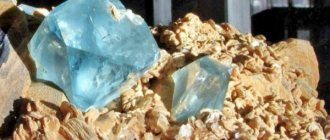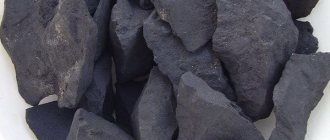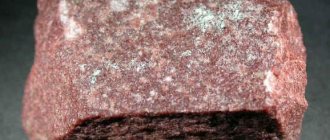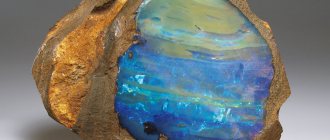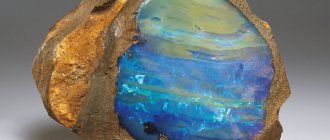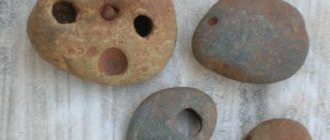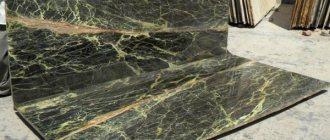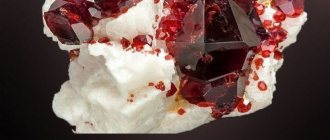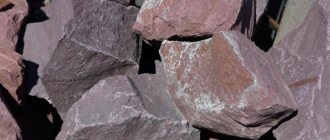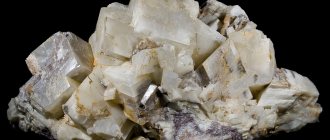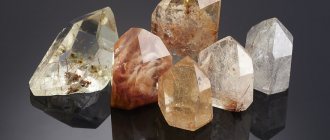Soapstone chlorite. Photo by Leroy Merlin
Not all stones created by nature find active use in human life. But soapstone chlorite was lucky. It has been known and actively used since ancient times in different parts of the world. This continues to this day.
Let’s try to figure out why soapstone is so useful for humans, and also describe the main areas of its application.
Story
Soapstone chlorite, embanked
The history of soapstone chlorite dates back more than one thousand years. This is evidenced by archaeological excavations.
In ancient Egypt and Scandinavia, dishes were made from stone. The mineral heats up quickly, maintains its temperature for a long time and does not absorb cooking ingredients.
In areas with frosty winters, stoves were made from soapstone and used to insulate homes.
In Rio de Janeiro, Brazil, a statue of Jesus Christ was erected from soapstone on a reinforced concrete frame.
Artificial fire opal
It’s good that science has made great strides forward, and those who admire the beauty of this stone can afford to purchase the gem.
After all, its cost is much lower than natural stones, and it will not suppress your energy, because the magical and healing properties are not preserved in artificial stones. It is not so fragile and therefore can be used in all products. It will take our planet thousands of years to create natural opals, it still needs to be found, and it is difficult to process. And the beauty of the gem has already captivated many. And so, science helped us in creating artificial opal. By growing a mineral structure similar to the natural one, artificial fire opal is obtained.
Other names for the stone
Soapstone figures (Africa)
Soapstone has many other synonymous names that are used in everyday life:
- wen - the stone is called so for its oily sheen;
- hot stone (in Finnish - tulikkivi) - for the property of the mineral to heat up quickly and retain heat for a long time;
- steatite – translated from French as “fat”;
- soap or wax stone - soapstone feels like a piece of soap or wax to the touch;
- stove or pot stone - called depending on the area of application.
Bath attendants' advice
Bath stoves are allowed to be filled with several varieties. Minerals with the lowest heat capacity are placed at the bottom, then with the average value, and at the top - with the highest value.
Bath attendants advise:
- replace the mineral filler every 3–4 years (porcelain, cast iron and stainless steel products last for decades);
- soapstone is often washed from dust, calcined and washed again with water, dried;
- When selecting mineral backfill, you need to buy/collect samples with the least porosity and high specific gravity.
It is better to buy bath filling in stores. The product is tested for safety and treated against fungi and infections. They have a large assortment of minerals of different fractions. They also sell mixes: 2–5 types of stones in one package.
| Oven type | Ideally | Recommended for backfilling | Suitable for use in baths/saunas |
| Boulders in contact with fire (Kuznetsov designs or periodic action) | Jade, cast iron, chromite | Porcelain balls, quartz | Varieties of dunite, soapstone, rodingite, porphyrite |
| Open heaters (minerals are doused with water) | Rodingite, quartz, jade | Jasper, jadeite, dunites | Chromite, gabbrodolerite, porphyrite, soapstone |
| Closed heaters, open bottom stoves | Porcelain, quartzite, cast iron grades SCh20, ChH16 | Jasper, quartz, rodingite | Dunites, jadeite, porphyrite, varieties of diabase, nephrite |
| Sauna stove (minerals are in contact with air: the top is open, the stones are held in place by a mesh around the structure) | Jasper, jade | Balls made of ceramics or porcelain, quartz, jadeite | Gabbrodolerite, rodingite, quartzite, dunites, chromite |
Natural minerals that do not contain harmful impurities are suitable for a Russian bath or Finnish sauna. There are many types of backfills and a wide price range. The cheapest of all is natural river boulder or sea pebbles. They cost from 10 rubles/1 kg.
What backfills are used in your bathhouse? Comment on the article, share your experience and interesting filling options. Send information to friends on social networks. Best wishes.
Physico-chemical characteristics
Soapstone is a magnesium silicate with a complex, constantly changing chemical composition. It consists of three independent minerals - talc, magnesite and chlorite. The main share in the composition of soapstone is magnesite and talc - 40-50% each. The proportion of chlorite, depending on the location of extraction, can reach 8%.
Main characteristics of the mineral:
| Index | Description |
| Formula | Mg₃[(Si, Al)₄O₁₀](OH)₂ × Mg₃(OH)₆ |
| Mohs hardness | 2-3 units |
| Density | up to 3.2 g/cm³ |
| Thermal conductivity | 3.3 W |
| Specific heat | 0.98 kJ/(kg x K) |
| Shine | matte, greasy |
| Transparency | opaque |
| Melting temperature | 1640°C |
Soapstone has a discreet gray color with inclusions of white, green, brown, blue and yellow shades. Specimens of red and cherry color are considered rare.
Description of varieties
The rich world of opals has a number of varieties. Fire opals are classified according to their color characteristics: hyacinth, red, orange, wine, terracotta, white, blue, indigo.
Orange and white
The orange glow of the ember inside the Mexican opal gave it the image of a precious stone.
The play of light rays is enhanced by a faceted cut with a gold frame. The opal itself is served in the shape of a circle or oval.
The mineral can even have white, muted and dull shades with creamy blurry spots. It is characterized by a glassy luster.
Lilac and blue
Red-orange opal tongues, intertwined with yellow ones, create the effect of blazing fire. But these stones may contain lilac and blue crystal lights.
They are called honeysuckle flowers. Sometimes pink or turquoise shades slip through the shimmer.
After polishing the mineral, a glassy shine appears, emphasized by the geometry of the square or rectangle of the processed stone. White gold or silver is used to frame this “cold” opal in jewelry.
Rare view
A rare type of opal is called “contra-loz” - “against the light” . If you look through the light, not just flashes of color appear inside the stone, but fantastic pictures. The effect is explained by different directions of light inside the mineral.
For the opportunity to see miniature pictures of the underwater world, a volcanic explosion or a sunset, you will have to pay at least 5 thousand dollars. Rare opals are considered a collector's item.
Bonfire and stars in stone
Among the very rare Mexican ones are star opals “pinfire” , which translates as “needle fire, fire” . Opalescence radiates from the center. Inside the stone, against the main background, small, up to 1 mm, sparkling stars of green, blue, and pink colors flash.
There are black opals with an orange bonfire inside.
Such minerals are prized by collectors and sell for a lot of money.
Glow in the dark
Some specimens of Mexican opal are capable of luminescing with a greenish-brown light. Not only fire stones have luminescence: noble white opal glows reddish.
Place of Birth
Extraction of soapstone chlorite Deposits
of soapstone chlorite are found on almost all continents.
It is mined in industrial quantities in Finland, the USA, Thailand, China, India and Brazil.
Russia ranks second in terms of production volumes among all suppliers of the mineral. The largest deposit is located in Karelia - a mountain ridge runs from the borders of Finland to Medvezhyegorsk. Soapstone chlorite is also mined in the Urals in the Shabrovskoye deposit.
Place of extraction
Deposits of fire stone are scattered across the planet: USA, Honduras, Brazil, Turkey, Czech Republic, Kazakhstan, Russia.
Uncut Fire Opal
90% of the mineral comes from Australia. Opals were discovered there by accident in the mid-19th century, and industrial development began decades later.
The homeland of the most beautiful specimens is Mexico. The largest fire stone was found here (143.2 carats, an exhibit in the collection of the Smithsonian Institution in the USA).
The rock is found on the slopes of extinct volcanoes or in rock faults.
Areas of application
Thanks to its versatile properties, soapstone is widely in demand not only in crafts, but also in the industrial industry.
Construction
Crushed and ground soapstone of technical quality is a raw material for refractories, cement compositions, and electrical insulators.
Soapstone is used to line the walls of residential buildings and swimming pools, and to install “warm floors”. Soapstone is also an excellent soundproofing material.
Arrangement of baths and saunas
Soapstone crushed for baths
Due to its high heat capacity and thermal conductivity, the mineral is used in the construction of baths, steam rooms and saunas. Stone blocks used in baths look aesthetically pleasing, reliable and environmentally friendly.
Drink stones
Soapstone quickly not only accumulates heat, but also cools. In status circles, it is used instead of ice cubes to quickly cool a drink without diluting it with water. To do this, the treated soapstone cubes are placed in the freezer for several hours, after which they are used for their intended purpose. Used pebbles are washed under running water and dried.
Decor
Protective amulet with the Algiz rune, soapstone
Soapstone is plastic and easy to process, so it makes beautiful decorative elements. Vases, figurines, animal figurines, boxes, and souvenirs are made from the mineral. Due to its high thermal conductivity, dishes made of soapstone are in demand. Food cooked in a pot or frying pan made from this stone remains warm for a long time.
Decorations
The stone is not popular among jewelers due to its excessive softness. However, it makes unusual jewelry, set in cupronickel or silver - beads, pendants, pendants.
Caring for Fire Opal Jewelry
The stone is fragile, so products made from it require special care.
It can even absorb oils and fats and is heat sensitive. Owners should protect them from contact with cosmetics and occasionally immerse them in water, since, losing moisture from its composition, the stone loses its best properties. You can store jewelry with gems in conditions of high humidity. Rings with fire opals are best worn on rare, most often special occasions, in the evening or going out.
In addition to all the warnings listed above, you should avoid exposing the gem to direct sunlight, and also avoid temperature changes, including frost.
How to clean stone?
It is better to do this in warm water using a soft cloth, then wipe dry. Ultrasonic cleaning of fire opals is contraindicated. Alkaline treatment is also dangerous, so soap should not be used when cleaning in water. You can also polish the stone by wiping it with a silk cloth.
Therapeutic effect
Bowl for aroma oils made of soapstone
Lithotherapists attribute biostimulant properties to soapstone. Its effectiveness has been proven in the following cases:
- improvement of brain function - memory restoration, increased concentration and logical thinking;
- treatment of hypertension, normalization of blood pressure by lowering it;
- treatment of osteochondrosis, radiculitis, Lumbago disease;
- increasing immunity;
- fight against viral and respiratory diseases.
There is an opinion that the stone releases vitamin D, which has a beneficial effect on the functioning of the musculoskeletal system, but representatives of traditional medicine do not confirm this.
To alleviate health conditions, they use soapstone heating pads, pebbles for massage, beads and simply amulets made of untreated stone.
Benefit
The popularity of soapstone as a bath stone is due to the healing properties of the mineral. He is appreciated for the fact that he:
- treats colds;
- eliminates inflammatory processes;
- improves metabolism;
- normalizes blood pressure.
It is believed that the stone is also endowed with healing “magical” properties. It is especially useful for men's health. It helps to cope not only with potency disorders, but also to avoid difficulties in your personal life.
Soapstone is an accessible mineral. You can purchase it for a price starting from 15 rubles. for 1 kg.
Price
Stone cubes for whiskey
The price of soapstone depends on the place of extraction of the mineral, its dimensions, color and quality of processing. The most expensive raw materials are those mined in Finland.
The cost of soapstone products is as follows:
- $16 – for a massager made of soapstone;
- $37-62 – for soapstone cubes for whiskey from Karelia in the amount of 10 pcs. depending on size;
- $60 – for a souvenir ball with a diameter of 50 mm;
- $100-110 for an animal figurine made of soapstone up to 12 cm high.
Rodingite rock
Rodingite is a metamorphic rock formed as a result of alteration of igneous deep rocks. The stone contains:
- feldspar;
- amphibole minerals;
- pyroxenes;
- precious chromium-vesuvian;
- pomegranate.
Rodingite is classified as a strong rock with a delightful bright color. Place of extraction: Middle Urals. The stone has an insignificant coefficient of thermal expansion, it is difficult to break down and wear out, so its service life is long. Due to its increased strength, it is not changed for a long time. Microparticles of the rock, in contact with hot water, impart healing properties to the steam.
Soapstone in astrology
Amulet made of soapstone
When choosing soapstone as a magical amulet or talisman, you should take into account its compatibility with the zodiac:
- The stone is ideal for Gemini, Pisces, Virgo and Libra. Representatives of these zodiac signs will gain calm and self-confidence, and get rid of their inherent fears and anxieties.
- Scorpios, Aquarius, Cancers and Capricorns can use soapstone, but not all the time. Otherwise, they may lose vigilance and confidence in their abilities.
- Taurus, Leo, Sagittarius and Aries are not recommended to wear this stone, as it negatively affects their character. Such negative qualities of these zodiac signs as ambition, selfishness and irritability increase several times when in contact with soapstone.
The magical properties of fire opal
In the East, especially in India, opals were deified.
They were considered stones of love, faith and compassion, and they also claimed that they, through the play of light, enlighten the mind and disperse dark thoughts and fears. Opals were endowed with the same properties in many European countries. These stones were associated with pure thoughts and were a symbol of happiness and love. In India they believed that opal promotes good communication between people. Perhaps the stone affects people's feelings and helps preserve love, but there are other examples where the gift of a stone led to the destruction of family life. It is believed that this fact happened between Napoleon and Josephine. So whether to believe or not to believe a gem, and in what cases, is your choice.
What is the difference from a fake?
Soapstone tiles 200*50*20
Soapstone is rarely counterfeited, using plastic as an imitation. It is quite simple to distinguish the original from the fake:
- soapstone is soft and easy to scratch and damage;
- this mineral has a heterogeneous color and discreet color;
- Soapstone leaves a white streak when rubbed across glass or other hard object.
Much more often soapstone is used to imitate jade because of its greenish color. The difference between the minerals is that the hardness of jade is higher compared to soapstone.
How to wear and care
Any stone is characterized by certain behavior in everyday life. The main thing is to know what he loves.
How to wear
Mexican opals contain a lot of water, and its loss can cause irreversible changes. The stone is able to restore water balance through the owner’s skin, so jewelry with it should be worn frequently.
Important! Opal jewelry should be worn carefully: no contrast showers, washing dishes with cleaning products, impacts or physical pressure on the stone.
Sometimes jewelry fades with frequent wear. This can be corrected by polishing with a soft cloth.
How to care
The mineral cannot withstand sudden changes in temperature, and if a transparent fire opal becomes covered with cracks, the situation cannot be corrected on its own. You'll have to go to a jewelry shop to have it re-polished (no guarantee).
Store opal in rooms with humid air. To slow down moisture loss, the gem is periodically immersed in clean water. Do not leave the stone in a sunny place or in bright artificial light for a long time.
Cleaning Rules
Opal is a delicate and capricious stone that requires constant attention.
After each wearing it should be wiped with a soft cloth.
Periodically, the mineral in the jewelry needs to be cleaned and polished . Ordinary warm water and a soft cloth - nothing else is required. Modern detergents with alkali are strictly contraindicated. After cleaning, the stone should be wiped dry and then passed over again with a soft cloth for polishing.
When purchasing a precious mineral, a person does not think about the complexity of the structure or the unpredictable nature of fire opal. Sometimes the price doesn’t scare you either. He's handsome, and that's all.
